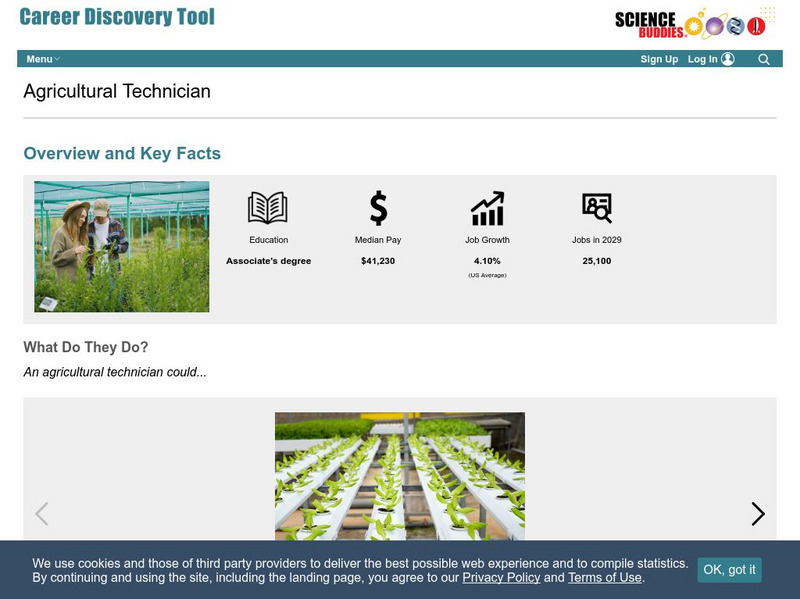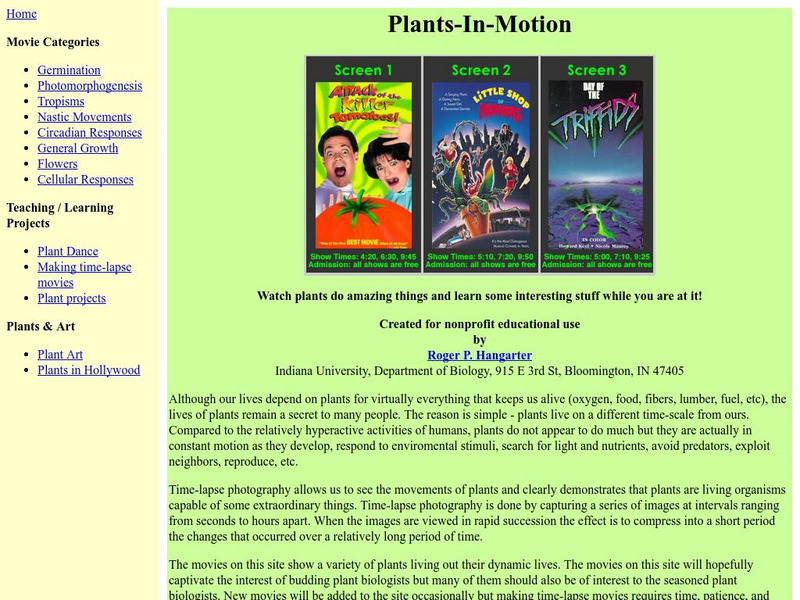Science Buddies
Science Buddies: Career Profile: Agricultural Technician
As the world's population grows larger, it is important to improve the quality and yield of food crops and animal food sources. Agricultural technicians work in the forefront of this very important research area by helping scientists...
Utah Education Network
Uen: Sprouting Scientists!
Observe and describe plants as they grow from seeds.
Indiana University
Indiana University: Plants in Motion
Plants grow and change on a time scale that is too slow for us to observe in real time. Time-lapse photography is a simple technique that allows us to see the movements of plants and clearly demonstrates that plants are living and...
Texas A&M University
Wildflowers in Bloom: Wildflowers
Start wildflowers from seed, find out what your hardiness zone is, learn about seed germination and sunlight needs of plants. All this and more.
ArtsNow
Arts Now Learning: Acting Hot and Cold [Pdf]
In this activity, 3rd graders will explore heating and cooling through pantomime. By enacting the effect of sunlight on a snowman and a growing seed, students will learn scientific information kinesthetically.
PBS
Pbs Teachers: Voices of Hope and Seeds of Peace (Lesson Plan)
A lesson plan that draws on the work of the Seeds of Peace, an international organization of teenagers from troubled regions of the world (with a focus on the Middle East) that fosters meaningful dialogue among people with opposing...
Missouri Botanical Garden
Missouri Botanical Garden: Tundra Plants
Visitors of this site will discover what plant life is found in the tundra and how they are able to survive the adverse weather conditions. Click on the yellow flower to start.
Other
My Science Box: Raising Plants
The objective of this lesson is to study the life cycle and structure of plants. Students learn about the concept of classifying objects as either living or non-living by growing plants from seeds, fertilizing them, collecting seed, then...
Museum of Science
Museum of Science and Industry: Online Science: Activities: Habitat Overcrowding
An experiment where several containers are set up with different numbers of seeds planted in each. The objective is to investigate how seed density affects the health of the plants that grow.
Read Works
Read Works: Pumpkin Time!
[Free Registration/Login Required] An informational text about how a seed grows into a pumpkin. A question sheet is available to help students build skills in reading comprehension.
E-learning for Kids
E Learning for Kids: Science: Hawaii: What Happens in the Life Cycle of a Flowering Plant?
Sophie and Max are growing plants in their greenhouse. Join them, and learn about the life cycle of a plant.
TOPS Learning Systems
Tops Learning Systems: Top Science: Monocots/dicots [Pdf]
Grow corn and bean seeds and measure their comparative growth over time.
Texas A&M University
Easy Gardening. . . Beets [Pdf]
Let's you know all about this cool weather crop. Soil Preparation, fertilizing, planting, varieties, insect concerns, harvesting and more. Requires Adobe Reader.
BiologyWise
Biology Wise: Lifecycle of a Plant
Describes the life cycle of a plant as it develops from a seed into a seedling, grows into a mature plant, develops flower buds, goes through pollination and double fertilization, and produces seeds.
Can Teach
A Demonstration of Photosynthesis and Transpiration
Students of all ages wonder what happens to a seed when you plant it in the ground. Try this basic experiment and let them explore, pose questions, and make predictions.
Other popular searches
- Growing Seeds Sequence Story
- Plants and Seeds Growing
- Growing Seeds Math
- Growing Bean Seeds Pea
- Growing Seeds Spring
- Growing Seeds to Vegetables
- Growing Seeds Into Vegetables
- Growing Seeds Lesson Plan
- Growing Seeds in Sponges
- Soil for Growing Seeds









